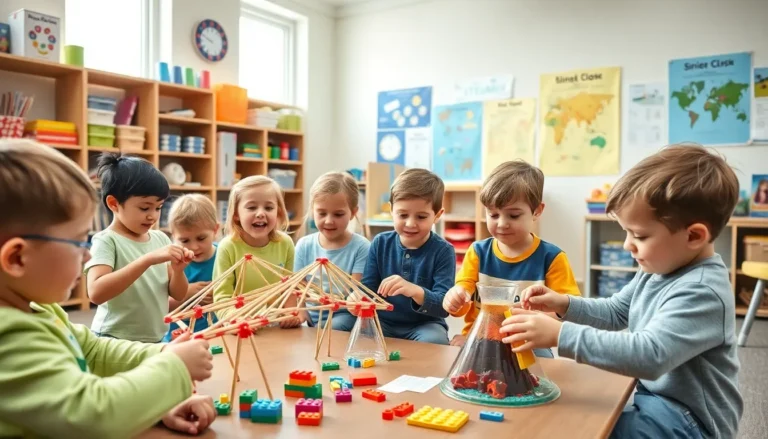Table of Contents
ToggleIn a world where kids are glued to screens, preschool STEM activities are the ultimate antidote. Imagine little ones exploring the wonders of science, technology, engineering, and math while having the time of their lives. These activities not only spark curiosity but also lay the groundwork for critical thinking skills. Who knew that building a tower out of spaghetti could turn a future architect into a pasta-loving genius?
Overview Of Preschool STEM Activities
Preschool STEM activities offer engaging experiences that nurture young children’s interests in science, technology, engineering, and math. These activities not only encourage exploration but also promote critical thinking skills. By providing hands-on opportunities, educators help children grasp complex concepts in an enjoyable manner.
Examples of preschool STEM activities include building structures using everyday materials like blocks, straws, or even pasta. Such tasks foster creativity and inspire problem-solving skills. Many educators incorporate experiments that allow kids to observe changes in materials, like mixing baking soda and vinegar to create a fun chemical reaction.
Incorporating outdoor exploration also proves beneficial. Nature walks enable children to investigate their environment, observing plants, insects, and weather changes. Each observation fuels curiosity while improving their observational and analytical skills.
Using technology, educators introduce children to simple coding games and apps. These resources teach fundamental programming concepts, laying a foundation for future learning. Activities that involve counting, sorting, and measuring develop essential math skills, reinforcing their understanding of numbers and relationships.
Group projects further enhance social skills. Children collaborate, share ideas, and learn to communicate effectively. Such experiences also teach them the importance of teamwork and perseverance when facing challenges.
Integrating arts with STEM creates STEAM, merging creativity with analytical thinking. Activities like building a birdhouse or designing a simple robot encourage imaginative play while reinforcing engineering principles.
Overall, preschool STEM activities create a holistic learning environment, promoting curiosity and a love for discovery that benefits children long after their preschool years.
Benefits Of STEM Activities For Preschoolers
STEM activities significantly enhance preschoolers’ overall development through various avenues.
Cognitive Development
Engaging in STEM activities stimulates cognitive development in preschoolers. Children exercise problem-solving skills while building structures or conducting simple experiments. They learn to think critically as they explore concepts like balance and measurement. STEM projects require observation, which fosters analytical thinking and reasoning skills. Hands-on experiences, such as mixing different materials, improve their understanding of cause and effect. These activities nurture curiosity and prompt questions, laying a foundation for lifelong learning. Moreover, they encourage children to experiment, promoting resilience when faced with challenges.
Social Skills Enhancement
Collaborating on STEM projects boosts social skills among preschoolers. Working in teams fosters communication as they share ideas and solutions with peers. Group activities allow children to practice listening and respect others’ opinions. They learn to negotiate roles and responsibilities, enhancing their ability to collaborate. Engaging in these activities also builds confidence as children celebrate their achievements together. Through teamwork, they cultivate empathy towards one another, understanding the importance of supporting each other. Additionally, integrating elements of play within these projects encourages positive interactions, helping to establish a budding sense of community.
Popular Preschool STEM Activities
Preschool STEM activities captivate young learners, blending fun with education. Engaging in these activities cultivates creativity and critical thinking.
Science Experiments
Science experiments spark curiosity in preschoolers. Simple tasks such as observing plant growth illustrate biology concepts. Mixing baking soda with vinegar introduces chemical reactions, engaging children in hands-on learning. Exploring how temperature affects ice melting enables kids to grasp essential scientific principles. Creating slime helps them understand states of matter while experiencing sensory play. Providing ample opportunities for exploration allows children to ask questions and develop a love for science.
Engineering Challenges
Engineering challenges inspire problem-solving skills among preschoolers. Building structures from blocks or recycled materials encourages creativity and critical thinking. Designing bridges with various shapes tests their understanding of balance and stability. Using teamwork to construct towers promotes communication and collaboration. Initiating challenges, like making a catapult from everyday items, fosters innovation and experimentation. Engaging children in these tasks develops their ability to plan and execute ideas effectively.
Math Games
Math games offer a playful approach to basic math concepts. Counting objects during play enhances numerical skills. Sorting shapes and sizes sharpens classification and spatial awareness. Activities like building with blocks promote understanding of geometry and measurements. Integrating patterns with colors helps preschoolers begin to recognize sequences and symmetry. Playing board games reinforces counting and strategic thinking, making math enjoyable and relevant.
Tips For Implementing STEM Activities At Home
Implementing STEM activities at home can enhance learning and curiosity among preschoolers. Parents play a crucial role in creating engaging experiences.
Creating A STEM-Friendly Environment
A STEM-friendly environment encourages exploration. Organizing supplies like blocks, art materials, and science kits fosters creativity. Setting aside a designated area for STEM projects provides structure. Using natural elements, such as rocks and leaves for experiments, promotes outdoor learning. Displaying children’s completed projects motivates them to engage further in STEM. Inviting open-ended questions during playtime enhances critical thinking. This kind of environment supports a child’s natural inquisitiveness.
Engaging Activities For Parents And Kids
Engaging activities bring parents and kids together in the STEM journey. Starting with simple science experiments can spark interest, like mixing baking soda and vinegar to create a reaction. Building a bridge with various materials challenges children’s engineering skills. Exploring coding through interactive apps introduces technology concepts. Participating in math games, such as shape sorting, reinforces numerical skills in a fun way. Taking nature walks allows children to observe and discuss scientific phenomena. Sharing these experiences cultivates a love for learning while strengthening family bonds.
Conclusion
Preschool STEM activities play a vital role in shaping young minds and nurturing a lifelong love for learning. By engaging in hands-on experiences, children develop critical thinking and problem-solving skills while fostering creativity and collaboration. These activities not only counteract excessive screen time but also promote social interaction and teamwork among peers.
Parents can significantly enhance their children’s learning journey by creating a supportive environment that encourages exploration. Simple experiments and engineering challenges can transform everyday moments into valuable learning experiences. Embracing STEM at an early age lays a strong foundation for future academic success and instills a sense of curiosity that lasts a lifetime.






